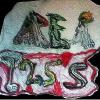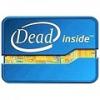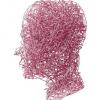Yes, from my own experience also it is very clear that we don't want our NMDA receptors to be antagonized and instead we want them to be activated and functional. It seems to be a key switch in the brain that turns everything else on.
My quest is to find a sustainable way to upregulate and stimulate those receptors. You say antagonism is bad but my idea has always been that using an NMDA antagonist might lead to upregulation in the long run. You yourself mentioned that we should try to predict the homeostatic response of the body. Wouldn't agonizing with sarcosine or anything else lead to downregulation in the long term?
DHEA, PREGNENOLONE; take those as positive allosteric modulators of NMDA-glutamate receptors, and yes, blocking NMDA may worsen OCD for many. Agonizing it should help both schizophrenia and OCD.
DIHYDROTESTOSTERONE; as shown below, upregulates NMDA and increases binding...thus
----------------------------------------------------------------------------------------------------------------
THE ANSWER TO ACTIVATING AND UPREGULATING NMDA IS....
--------------------------------------------------------------------------------
DHT, PREGNENOLONE, AND DHEA....good for anxiety, OCD, depression, libido etc
----------------------------------------------------------------------------------------------------------------
- Use creatine and protodioscin to boost DHT naturally.
- You can easily buy pregnenolone and DHEA for cheap online.
http://molpharm.aspe...ontent/40/3/333
http://en.wikipedia....anism_of_action
Book on NeuroSteroids ; NMDA SECTION
Endocrinology. 2005 Apr;146(4):2091-7. Epub 2005 Jan 20.
Dihydrotestosterone increases hippocampal N-methyl-D-aspartate binding but does not affect choline acetyltransferase cell number in the forebrain or choline transporter levels in the CA1 region of adult male rats.AbstractTestosterone, acting through its androgenic metabolite 5alpha-dihydrotestosterone (DHT), can increase dendritic spine density in the CA1 region of the male rat hippocampus. The mechanisms mediating this increase in spines are presently unknown. In female rats, estrogen (E) has been shown to increase spine density, which is in part mediated by increases in N-methyl-d-aspartate (NMDA) receptors in the CA1 region and cholinergic forebrain inputs to the hippocampus. Whether similar mechanisms are responsible for the DHT-induced increase in spines in the male remains to be determined. In the first experiment, we used [(3)H]glutamate NMDA receptor binding autoradiography to assess whether DHT-treated males had higher NMDA receptor levels in the CA1 region of the hippocampus, compared with oil-treated males. In the second set of experiments, we used choline acetyltransferase (ChAT) in situ hybridization and immunohistochemistry to assess whether DHT could affect ChAT cell number in the forebrain. We also investigated the effect of DHT on hemicholinium-3-sensitive choline transporter levels in the CA1 region of the male hippocampus. We found that DHT significantly increased NMDA receptor binding in the CA1 region of males but had no effect on ChAT cell number in the forebrain or hemicholinium-3-sensitive choline transporter protein levels in the CA1 region. These data indicate that, similar to E-induced spinogenesis in females, DHT-induced increases in spine formation in males may require increases in NMDA receptors. However, unlike E-treated females, these data suggest that DHT does not influence cholinergic inputs to the hippocampus.
PMID: 15661864 [PubMed - indexed for MEDLINE]
























































